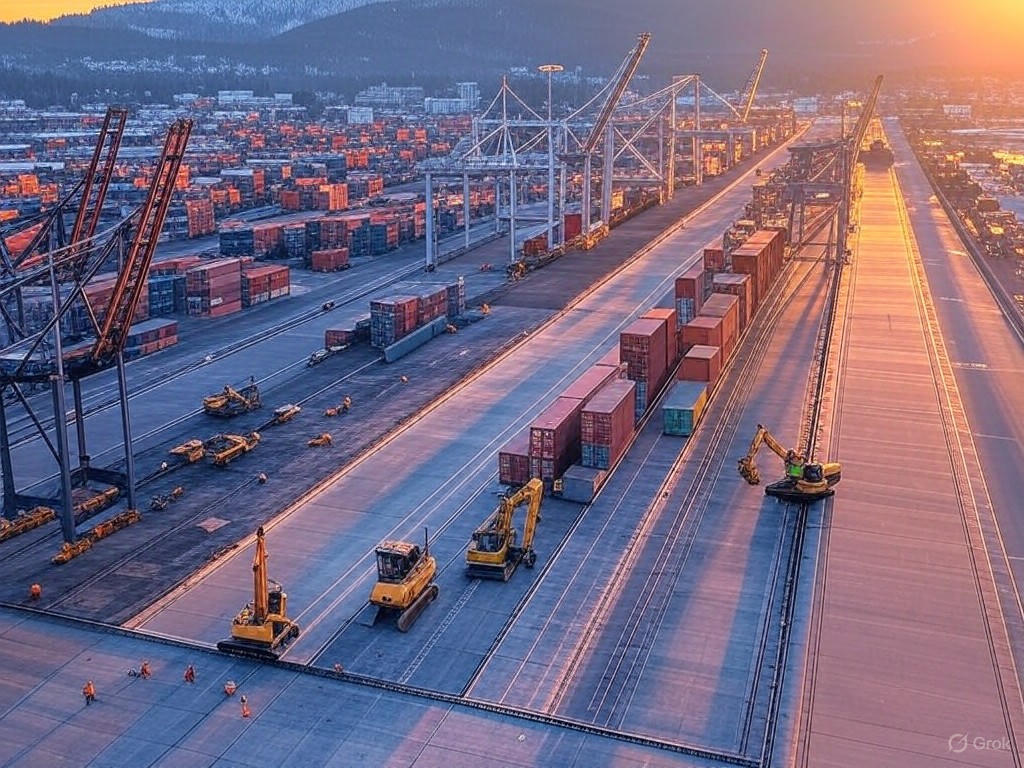BC’s Infrastructure Push: Global Economic Gains?
In the vast expanse of Canada's western frontier, where rugged mountains kiss the sky and ancient forests whisper tales of endurance, British Columbia stands at a pivotal crossroads. Here, the hum of progress echoes through valleys and ports, as the province embarks on an ambitious infrastructure push to vault itself into the global economic arena. Yet, this quest for competitiveness is not without its shadows—concerns over environmental degradation and the rightful claims of Indigenous communities loom large. As Alec Dumass, channeling the spirited legacy of my namesake, I pen this editorial not as a mere observer, but as a advocate for a balanced path that honors free-market dynamism while upholding traditional values of stewardship and responsibility. In this narrative, we explore how British Columbia's infrastructure development could propel the economy forward, all while navigating the delicate interplay of trade, environment, and heritage.
The Economic Imperative: A Bold Leap for Global Trade
British Columbia's infrastructure initiatives represent a daring bid to enhance global economic competitiveness, transforming the province into a linchpin of North American trade. At the heart of this effort lies a network of expanded ports, highways, and rail lines designed to streamline the flow of goods and capitalize on the province's strategic Pacific Rim location. Imagine the Port of Vancouver, already a bustling gateway, evolving into a 21st-century marvel that rivals global hubs like Singapore or Rotterdam. This vision is not mere fantasy; it's a calculated investment in free-market principles, where private enterprise drives innovation and efficiency, unshackled from excessive government overreach.
The economic stakes are high. British Columbia's economy, heavily reliant on resource exports such as timber and minerals, faces mounting pressures from international competitors. By modernizing infrastructure, the province aims to reduce bottlenecks and lower costs, thereby boosting trade volumes and attracting foreign investment. According to a recent analysis by the Fraser Institute Fraser Institute Report, investments in transportation infrastructure have historically yielded a 5:1 return on investment, underscoring the multiplier effect on GDP and job creation. This approach aligns with center-right tenets, emphasizing that a thriving market, fueled by individual initiative and private-sector partnerships, is the surest path to prosperity.
Yet, this economic surge must be grounded in reality. Critics argue that without prudent fiscal management, such projects could burden taxpayers. Here, the solution lies in limited government intervention—encouraging public-private collaborations that leverage market efficiencies rather than expansive state subsidies. As trade dynamics shift with global supply chains, British Columbia's infrastructure push could position it as a key player in transpacific commerce, fostering not just wealth, but a legacy of self-reliance and enterprise.

Vessels queue at an expanded Port of Vancouver, symbolizing British Columbia's gateway to global markets and the dawn of economic renewal.
Weighing the Costs: Environmental and Indigenous Realities
No great endeavor is without its trials, and British Columbia's infrastructure development is no exception. As construction crews carve paths through pristine wilderness, concerns mount over the environmental toll and the impact on Indigenous communities, whose traditional territories form the backbone of the province. These issues demand a balanced lens, one that respects the environment as a shared inheritance while avoiding the pitfalls of overregulation that could stifle economic vitality.
Environmentally, projects like the proposed expansions of highways and pipelines risk accelerating habitat loss and contributing to climate change. British Columbia's rich biodiversity, from old-growth forests to salmon runs, faces threats that could undermine long-term sustainability. A study from the World Economic Forum World Economic Forum Insight highlights that unchecked development in resource-dependent regions can lead to a 20–30% increase in carbon emissions, potentially offsetting economic gains. Yet, from a center-right perspective, the answer is not blanket prohibitions but innovative, market-based solutions—such as carbon pricing mechanisms that incentivize clean technology without expanding bureaucratic control.
Equally pressing are the Indigenous costs. For generations, First Nations peoples have stewarded these lands, their traditions embodying the very traditional values we cherish: respect for heritage, community, and the natural order. Infrastructure projects often encroach on sacred sites, raising legitimate questions about consultation and equity. The Wall Street Journal recently covered a similar debate in Canadian resource development Wall Street Journal Analysis, noting that meaningful engagement can lead to mutually beneficial outcomes, such as revenue-sharing agreements that empower communities economically. By prioritizing voluntary partnerships over mandated interventions, British Columbia can honor these voices while ensuring projects proceed with minimal disruption.
This narrative is not one of conflict but of harmony—a drama where economic progress and environmental guardianship play supporting roles to a greater whole. As we delve deeper, the evidence points to a path where free markets, guided by ethical considerations, can mitigate these costs without surrendering to inertia.

Indigenous elders survey a construction site in British Columbia's interior, embodying the province's effort to blend economic advancement with cultural respect.
Evidence and Pathways: A Measured Approach to Growth
The evidence for British Columbia's infrastructure strategy is compelling, yet it underscores the need for judicious balance. Data from Statistics Canada Statistics Canada Trade Report reveals that infrastructure investments have correlated with a 15% uptick in export volumes over the past decade, particularly in sectors like technology and agriculture. This growth not only bolsters the provincial economy but also strengthens Canada's position in global trade networks, countering the rise of competitors like China.
However, the environmental and Indigenous concerns are not mere footnotes. A report by the Pembina Institute, a non-partisan energy think tank Pembina Institute Study, estimates that without adaptive measures, new projects could degrade up to 10,000 hectares of wilderness. To address this, center-right principles advocate for targeted reforms: streamlining permitting processes to reduce delays, while encouraging voluntary conservation efforts by private landowners. Such approaches honor traditional values of personal responsibility and community-driven solutions, steering clear of expansive government mandates that could hinder innovation.
In practice, success stories abound. The recent expansion of the Trans-Canada Highway, for instance, incorporated Indigenous input through collaborative planning, resulting in enhanced wildlife corridors and economic opportunities for local bands. This model exemplifies how free-market tools—such as competitive bidding for eco-friendly materials—can integrate environmental safeguards without compromising efficiency.
Conclusion: Charting a Course of Resilient Prosperity
As the sun sets over British Columbia's majestic peaks, the province's infrastructure odyssey stands as a testament to human ambition tempered by wisdom. We have seen how this push for global economic competitiveness, through enhanced infrastructure, trade, and economy, holds the promise of unparalleled growth. Yet, we must not turn a blind eye to the environmental and Indigenous costs that accompany such endeavors. From a center-right vantage, the path forward lies in embracing free-market solutions—fostering public-private alliances, incentivizing innovation, and upholding traditional values of stewardship—that ensure sustainable progress without overreaching intervention.
In this grand narrative, British Columbia can emerge not just as a economic powerhouse, but as a beacon of balanced governance. Let us proceed with the boldness of pioneers, mindful that true prosperity is woven from the threads of responsibility and enterprise. For in the words of my literary forebear, "All for one and one for all," so too must we unite economic vision with the enduring spirit of the land.

